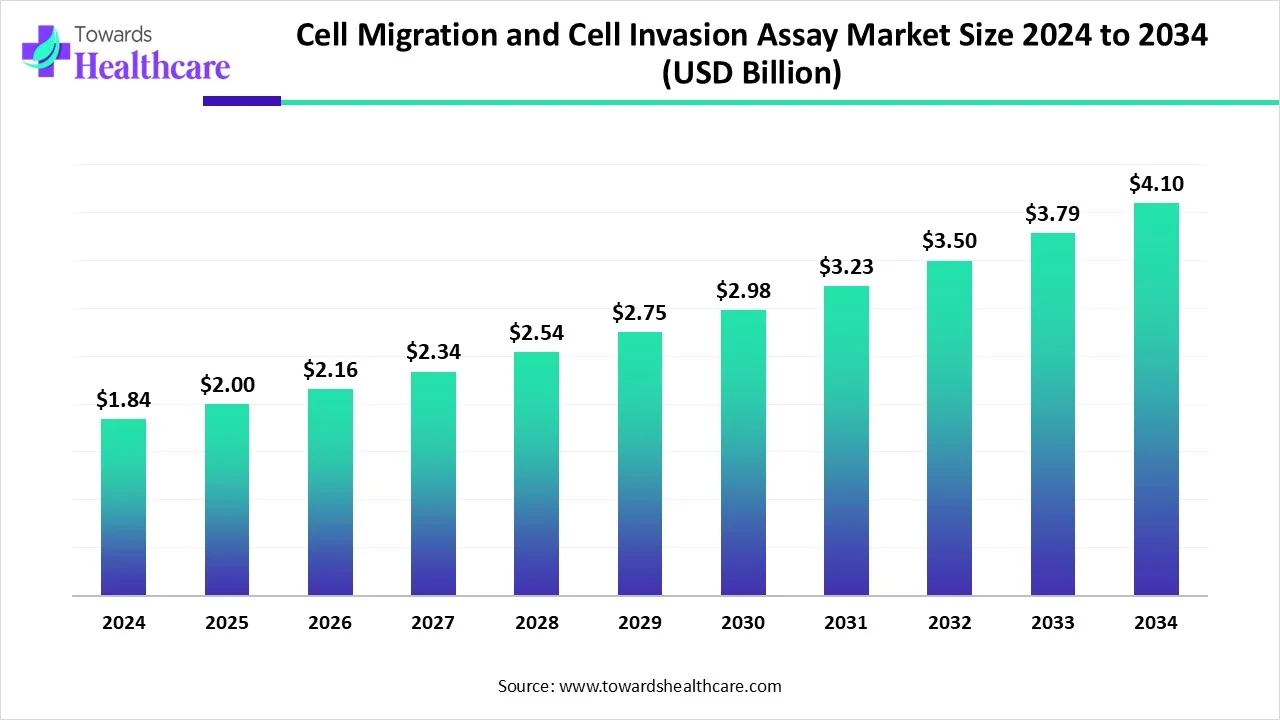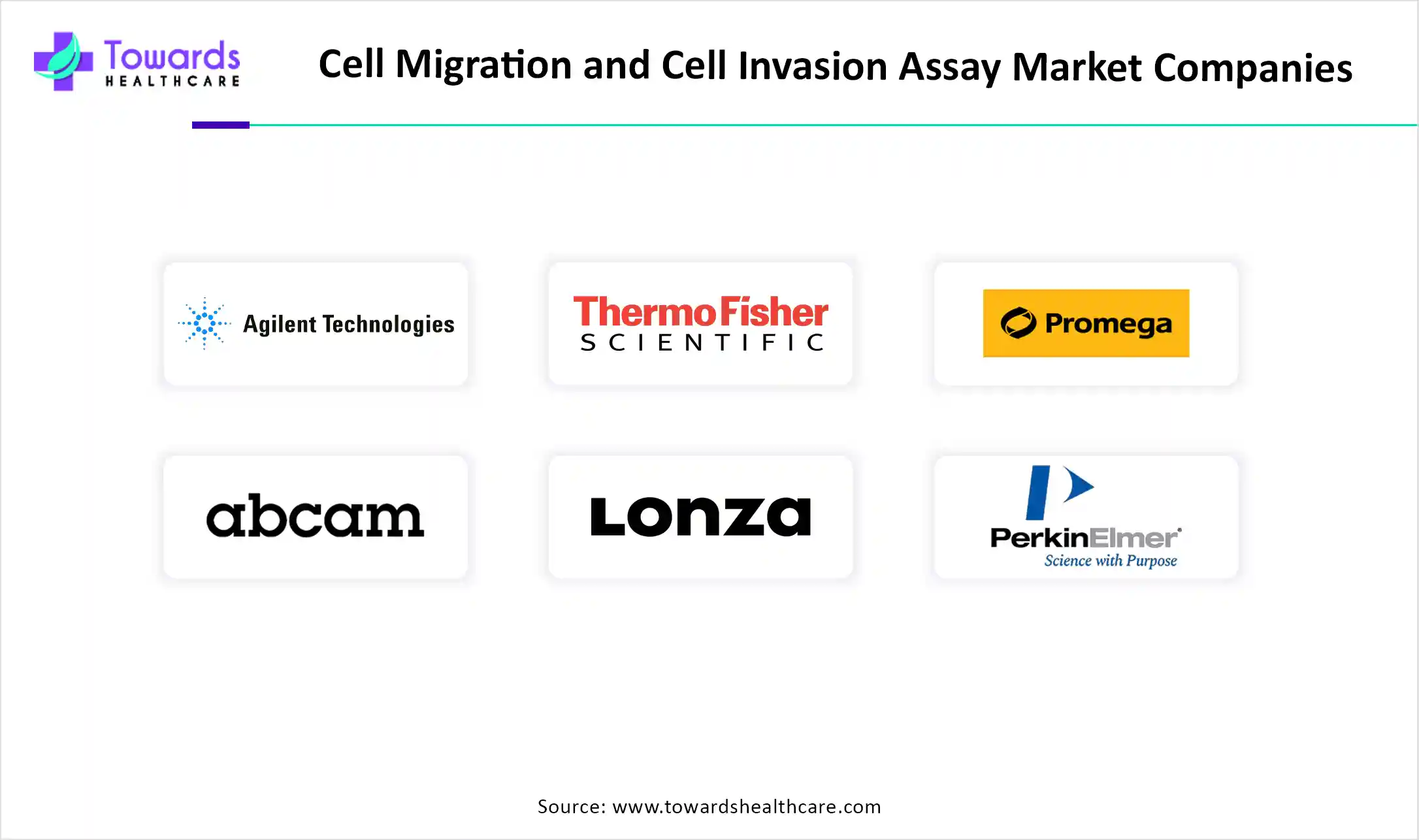December 2025

The global cell migration and cell invasion assay market size is calculated at USD 1.84 in 2024, grew to USD 2 billion in 2025, and is projected to reach around USD 4.1 billion by 2034. The market is expanding at a CAGR of 8.34% between 2025 and 2034.
Numerous efforts have been made by researchers worldwide to employ these platforms for the diagnosis of a wide range of illness indications due to the numerous benefits that these cell-based assays offer. The adoption of these assays in the drug development process by life science businesses to identify possible lead candidates has been prompted by technological improvements. A number of pharmaceutical companies have created tests for cell invasion and migration in an effort to speed up the diagnostic process and combat the growing number of cancer reports worldwide.

| Metric | Details |
| Market Size in 2025 | USD 2 Billion |
| Projected Market Size in 2034 | USD 4.1 Billion |
| CAGR (2025 - 2034) | 8.34% |
| Leading Region | North America |
| Market Segmentation | By Assay Type, By Application, By End-User, By Region |
| Top Key Players | Agilent Technologies, Thermo Fisher Scientific, Promega Corporation, Abcam, Corning Incorporated, Cell Biolabs, Lonza, Sigma-Aldrich, BD Biosciences, PerkinElmer, BioVision, Miltenyi Biotec, Fisher Scientific, Essen BioScience (part of Sartorius), Cell Signaling Technology, Enzo Life Sciences, Biotium, Trevigen, R&D Systems, UltraNanoTech. |
Among the critical physiological processes that cell migration affects are morphogenesis, tissue regeneration, and immune responses. The aberrant invasion and migration of cells into adjacent tissue is another feature of metastatic disease. Finding treatments for diseases and expanding our understanding of developmental biology depend on reliable quantitative techniques for evaluating cell invasion and migration. Equipment for cell analysis, including sensitive impedance-based formats, automated imaging, and plate reader-based techniques, provides robust choices for real-time measurements of cell invasion, migration, and chemotaxis.
AI and machine learning are being used in assays for data analysis to improve efficiency and accuracy. Automating test methods reduces human error, increases throughput, and speeds up drug development. AI and automation have several benefits for the market for cell migration and invasion test services, one of which is the enhanced integration of complex data that makes it easier to extract valuable insights for clinical and research applications. Improved test data quality and consistency while reducing human intervention.
Investments in Drug Discovery
The growing investment in drug discovery and development is one of the main factors driving the market for tests measuring cell invasion and migration. These experiments are crucial for determining if new drugs can stop or promote cell invasion and migration, which are crucial processes in the development of cancer and other diseases. The growing focus on medication development is directly driving the demand for advanced cell migration and invasion testing, which facilitates the discovery of new treatment strategies.
High Cost of Cell Assays
Even though the market for cell invasion and migration assays has grown significantly, several constraints are impeding its growth. The high expense of sophisticated assay methods and the requirement for specific tools and chemicals are among the main barriers that may prevent smaller labs and organizations from using them.
What are the Opportunities in the Cell Migration and Cell Invasion Assay Market?
There are several lucrative possibilities available to stakeholders in the market. The increasing collaboration among academic institutions, biotechnology companies, and pharmaceutical firms fosters innovation and enhances research capabilities. Furthermore, the growing emphasis on tissue engineering and regenerative medicine opens up new possibilities for test applications. As researchers continue to examine the dynamics of cell activity in various contexts, there is a lot of potential for developing novel assays tailored to certain therapeutic areas. The expansion of research into other diseases, such as autoimmune and cardiovascular disorders, may also be driving the demand for these tests.
By assay type, the cell migration assay segment held the largest share of the cell migration and cell invasion assay market in 2024. Cell migration, or the movement of cells, is important for immunology, wound healing, the development of embryos, and abnormal cellular processes, including the spread of cancer. Both "scratch" assays and experiments using microplates with pre-formed "wounds" are commonly employed for measuring cell motility in a controlled setting when conducting cell migration studies.
By assay type, the cell invasion assay segment is expected to be the fastest-growing in the cell migration and cell invasion assay market during the forecast period. Assays for cell invasion are often used in cancer research, especially when combined with studies on cell migration. Their method for investigating cell migration and the processes by which cells invade other cells is flexible and high-throughput. Several methods for testing cell invasion are quick and simple to apply, and they also offer the benefit of real-time data.
By application, the cancer research segment led the cell migration and cell invasion assay market in 2024. For many patients, cancer metastases and the burden of secondary tumors are the leading causes of death, making up about 90% of cancer-related fatalities. Transwell assays, 2D cell migration, scratch/wound assays, and inverted invasion assays are among the assays used to investigate cancer cell movement and invasion.
By application, the immunology segment is estimated to grow at the fastest rate in the cell migration and cell invasion assay market during the forecast period. The movement and interactions of immune cells inside tissues, as well as their relationship to immune responses and diseases, may be investigated in immunology using cell migration and invasion assays. These tests may be used to study how cells migrate toward chemoattractants (chemotaxis) and how they can pass through an extracellular matrix (ECM), which is important for processes including immune responses and cancer metastasis.
By end-user, the pharmaceutical and biotechnology companies segment held the major share of the cell migration and cell invasion assay market in 2024. Its objective is to cover the most recent and noteworthy developments and breakthroughs in the field of pharmaceutical biotechnology. Pharmaceutical biotechnology research intersects with pharmacological research, including in vitro preclinical and clinical trials, and drug development. The development of new pharmaceutical substances, processes, services, and technologies is largely dependent on biotechnology.
By end-user, the contract research organizations segment is expected to grow at the fastest rate in the cell migration and cell invasion assay market in the upcoming period. In the dynamic biotech and pharmaceutical sectors, the role of a full-service CRO is more crucial than ever. CROs are essential collaborators for biotech and pharmaceutical firms, offering comprehensive support throughout the drug development process. The development of biotechnology and medicines depends on clinical trials, but because of their complexity, they require expertise, resources, and a strong commitment to quality. Full-Service Contract Research Organizations (CROs) offer a number of benefits and excel in this field.
North America dominated the cell migration and cell invasion assay market in 2024. The established healthcare system, substantial research expenditures, and the growing prevalence of chronic diseases like cancer are all major factors contributing to North America's dominance. As the second leading cause of mortality in the United States, cancer calls for advanced diagnostic tools, including cell invasion and migration testing, according to the Centers for Disease Control and Prevention (CDC).
It is vitally crucial to continue funding biomedical discovery research at a time when the scientific community is making tremendous progress in these and countless other areas of cancer research. To better assist researchers in these trying times, Foti introduced the new AACR Trailblazer Cancer Research Grants in addition to the funding programs that AACR currently hosts. Early-stage investigators will get nine awards totaling $1 million, while mid-career investigators will receive six grants totaling $1 million. This $15 million investment is the largest single grant program the AACR has ever presented.
Canadian research is essential to promoting innovation, generating scientific discoveries, and establishing Canada as a world leader. For this reason, the Canadian government is funding the next generation of problem solvers to help innovative initiatives that tackle global issues, enhance health outcomes, and build stronger communities. In order to promote science and research nationwide, the federal government is spending about $308 million, according to the Minister of Innovation, Science, and Industry. The New Frontiers in Research Fund's (NFRF) Transformation stream will disburse around $142 million. Furthermore, 38 research institutions will receive more than $153 million to fund 179 new and renewed Canada Research Chairs.
Asia Pacific is estimated to host the fastest-growing cell migration and cell invasion assay market during the forecast period. The biotechnology industry is receiving more and more funding from governments in this area, with a focus on cancer research and the creation of customized therapies. One of India's biggest public health issues, according to the Ministry of Health and Family Welfare, is cancer, which makes sophisticated research instruments necessary.
According to the most recent "2025 Nature Index-Cancer" supplement, China has surpassed the United States as the world's largest provider of high-quality cancer research for the first time. It demonstrates that China's share in cancer-related research in 2024 was 2,614.5. The United States had a 2,481.7 share. In 2024, China's output increased by 19 percent over the year before.
Of the Rs 99,858.56 crore allocated to the Ministry of Health and Family Welfare, Rs. 95,957.87 crore has been set aside for the Department of Health and Family Welfare, while Rs. 3,900.69 crore has been set aside for the Department of Health Research. The Indian pharmaceutical industry is about to enter a revolutionary era as a result of the recent spike in exports of pharmaceuticals in 2025, which has the potential to drastically change the global healthcare landscape. India's pharmaceutical exports reached US$50 billion in 2025.
Europe is expected to grow significantly in the cell migration and cell invasion assay market during the forecast period. There are several esteemed research institutions and organizations in this area that are actively involved in cell biology and cancer research projects. Leading nations in this sector include Germany, the UK, and France, which are propelled by strong government assistance programs, industry-academia partnerships, and substantial financing for life science research.
A multi-billion-dollar agreement for the German business BioNTech in June 2025 is the most recent example of how crucial Europe's biggest economy is to efforts to treat the fatal illness. The agreement, which includes $3.5 billion in unconditional payments, supports BioNTech's goal of creating innovative cancer therapies. Germany's leadership in cancer research is highlighted by the massive agreement.
In order to draw in more investment from the pharmaceutical sector, the United Kingdom's government is beginning to realize that it must alter the way it pays for medications. VACCINE pioneer BioNTech committed to spending up to £1 billion (US$1.3 billion) in the UK in May 2025. The capital will be used to construct two drug research centers and an AI hub for the development of next-generation medications. Peter Kyle, the science and technology minister for the UK government, stated that this investment will take the life sciences industry, which drives growth, to new heights.

In February 2025, due to a lack of resolution and capability in our current omics-scale research tools, the dynamic protein interactions of a cell are mostly understudied. That was recently altered by our team of scientists, computational biologists, and software engineers, and we are thrilled to present an invention today that we think will eventually result in advances in the fields of immunology, hematology, cancer, and cell therapy research, said Simon Fredriksson, CEO and co-founder of Pixelgen. (Source - PR Newswire)
By Assay Type
By Application
By End-User
By Region
December 2025
December 2025
December 2025
December 2025